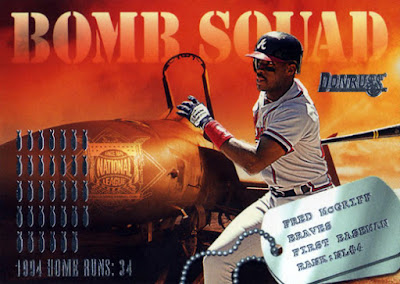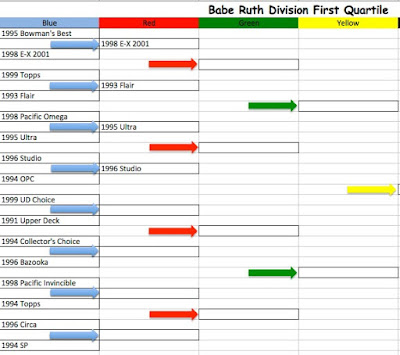Card #41912
2002 Upper Deck Ovation #37 J. D. Drew
Comments on the card/player: Drew was 5 for 13 (.385 average) with a home run in the 2002 NLCS between the Cards and the Giants but the Cards still lost.
How/When acquired: Bought several packs of Ovation for $0.34/card on 4/26/03. This was in the days when I had a local card shop I'd stop into every week and buy a few packs of stuff I didn't have.
Card #50003
2002 Stadium Club #3 Chipper Jones
Comments on the card/player: I'm not sure but that scoreboard looks like the one in Citizen's Bank Park where the Phillies play.
How/When acquired: Bought box of Stadium Club for $0.25/card on 2/8/02.
Card #39033
2009 Topps Allen & Ginter #54 Carlos Guillen
Comments on the card/player: I think that 2009 was when Topps first introduced these horizontal action cards into Allen & Ginter.
How/When acquired: Paid $0.42/card for hobby box of Topps Allen & Ginter on 8/30/09.
Card #8428
2010 Topps Update #327 Mike Stanton
Comments on the card/player: Remember Mike Stanton? He's known as Giancarlo Stanton these days. It's a card collector's cataloging nightmare when a player changes his name during his career.
How/When acquired: Paid $0.25/card for 2 10-pack blasters in December 2010.
Card #31386
2012 Topps #232 Mariano Rivera/Johan Santana/Felix Hernandez
Comments on the card/player: They were at the top of the game in 2012. Rivera - retired in September 2013; Santana - retired in August 2013; Hernandez - still going strong with a 14-7 record so far this year with a 3.65 ERA
How/When acquired: Paid $0.20/card for a hanger box of Topps in February 2012.
Card #39770
1988 Donruss #516 Manny Trillo
Comments on the card/player: Slick 2nd baseman for the Phillies 1979-1982. Was the NLCS MVP in 1980 putting the Phillies into the 1980 World Series.
How/When acquired: Don't know.
Card #24641
2009 O-Pee-Chee The Award Show #3 Brandon Phillips
Comments on the card/player: A 20-card insert in Upper Deck's abortive attempt to bring back the old O-Pee-Chee brand.
How/When acquired: Paid $0.17/card for MJ Holding repack in March 2011.
Card #15607
2009 Upper Deck Goodwin Champions #17 Rollie Fingers
Comments on the card/player: 2009 O-Pee Chee may have been a big bust, but 2009 Goodwin Champions was the last best thing Upper Deck did. Could have been serious competition for Allen & Ginter if Upper Deck hadn't bit the dust.
How/When acquired: Paid $0.23/card for 36-card jumbo and 10-pack (8 cards/pack) blaster in May 2009. Hobby boxes of this product are going for about $120 on eBay today.
Card #33898
1994 Score #78 Pete Harnisch

Comments on the card/player: The dark blue borders of this set make it very unattractive to me. Look for 1994 Score to lose it's first round in the 1990 Baseball Cards Showdown, no matter what card it is up against.
How/When acquired: Acquired in my 2012 Summer Clearance Trade.
Card #12405
2002 Fleer Showcase #123 Mike Lieberthal
Comments on the card/player: After a serious injury in 2001 (he tore his ACL, MCL and cartilage in his knee attempting to dive back to 1st base), Lieby was the Sporting News NL comeback player of the year in 2002.
How/When acquired: Acquired in a trade with a fellow blogger in 2009.



























































